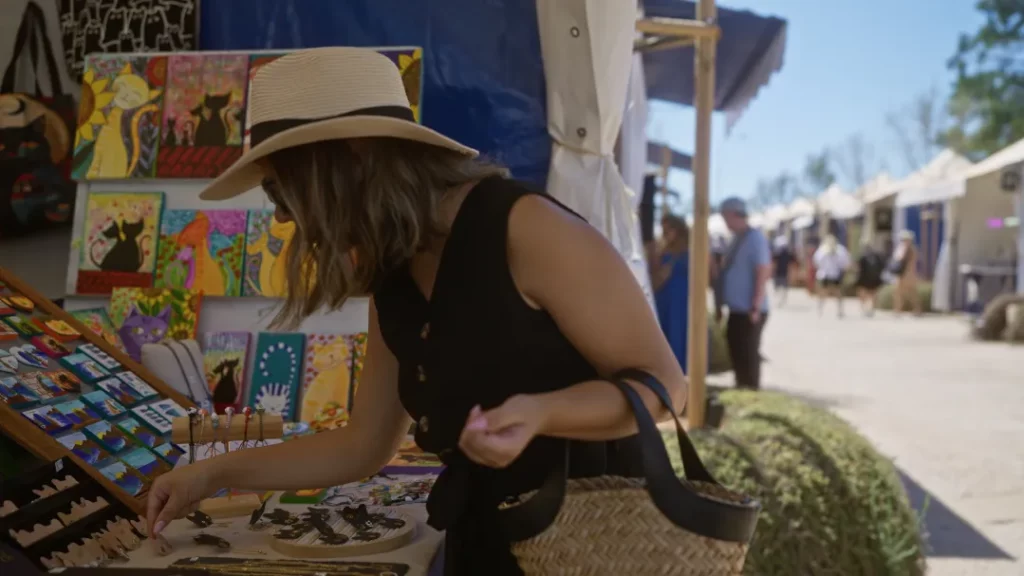Just like inspiration, mishaps can strike at any time. To prep your creative business against expensive, headache-inducing what-ifs, a craft risk assessment is essential for identifying potential problems and taking steps to lower risk.
Get proactive about your business with our free arts and crafts risk assessment below.
Download Free Arts & Crafts Risk Assessment Template
What Risks Do Artists and Crafters Face?
Artists and crafters face a wide array of risks at every stage of business operations, including:
- In-person sales: A customer gets hurt while shopping at your booth
- Online sales: Your product injures a customer after they receive it
- Workshops: An attendee’s property gets damaged during a session

The Risks of Selling Arts and Crafts at Events
Story Time: Riley creates colorful illustrated art and attends her first event as an art vendor. She’s designed and installed her booth perfectly, presenting her framed prints and gift cards on a tiered shelf.
Unexpectedly, the weather turns gray and stormy, and a strong gust of wind sends her tent flying into a neighboring vendor’s booth. Many of their glass pieces break, plus a customer suffers a laceration after getting hit by one of Riley’s airborne products.
The Aftermath:
- Riley is liable for the other vendor’s damaged property
- The event attendee requires stitches and asks Riley to pay for their medical bill
- Riley loses out on sales due to the early pack-up and damaged inventory
When you sell handmade products at events, you’re susceptible to risks like:
- Slip-and-fall incidents at your vendor booth (for example, over an extension cord)
- Customer injuries caused by your products (i.e., sharp displays, broken glass)
- Weather-related damage to other vendors’ property caused by your booth
- Damage to venue property caused by your booth setup or teardown
- Theft of merchandise or cash at your register
Using a craft stall risk assessment helps you become more aware of potential liabilities so you can attend events as prepared as possible — even if the weather is moody!
The Risks of Selling Products Online
Story Time: Kai is a metalworker who sells abstract sculptures through an online marketplace. He’s so excited that his art business is taking off after gaining traction posting time-lapse videos of his process on Instagram.
One day, a customer receives one of his pieces in the mail, but accidentally cuts themselves on a sharp edge while unboxing. Kai had carefully shipped the sculpture with bubble wrap and thick cardboard packaging, but the metal pierced through.
The Aftermath:
- Kai is liable for the customer’s injury
- The customer leaves a scathing online review of his shop, affecting sales
- Kai must do damage control and invest in enhanced packaging
Selling unique creations online opens up your business to risks like:
- Customer injuries or property damage caused by your products
- Data breaches leading to stolen customer information
- Theft of your original designs by other parties
- Negative online reviews that harm your reputation
- Customer fraud (i.e., chargebacks or unfounded disputes)
- Sales tax compliance issues
The Risks of Hosting Workshops and Demos
Story Time: Carol is an experienced artist who teaches a resin workshop for beginners. She always prefaces each class with safety precautions, such as the importance of protective gear and proper curing time.
But one eager student accidentally knocks over a cup of resin, which lands on their vintage leather handbag and the hardwood floor, hardening and causing permanent damage.
The Aftermath:
- Carol is responsible for paying to repair the venue floor
- The customer also demands a class refund and replacement costs for their bag
- Carol must cease business operations while she sorts the unexpected damages
Sharing your passion for creativity through workshops and demos is rewarding, but it also puts you at risk of:
- Participant injuries due to the mishandling of supplies
- Potential burns, cuts, or allergic reactions from materials
- Accessibility or fire hazards, such as a crowded classroom
- Dissatisfaction with your instruction or the experience
- Damage to the venue or participants’ property
There are so many ways your business can inadvertently cause damage. Curious about how much these oh-nos can cost you? Check out some real artist claims examples.
How to Reduce Risks and Protect Your Business
The two most crucial things you can do to protect your business are:
- Regularly use a craft risk assessment
- Carry liability insurance as a safety net
Beyond that, these are some specific steps to ensure your business continues to spark wonder and creativity — not costly accidents.
When Selling at Events
Selling arts and crafts at events, your main focus should be on reducing physical hazards as your business interacts with customers and passersby.
- Clearly label the intended use and materials of each product
- Use stable displays, weighted tents, and weather protection
- Keep walkways clear to reduce trip hazards
- Take photos of your booth setup in case of post-event disputes
- Store cash securely and avoid large amounts on hand
- Display large, sharp, or heavy products safely (i.e., with guards or strong mounts)
- Read event contracts carefully to understand your responsibility as a vendor
- At a minimum, carry general liability insurance (event insurance) to cover third-party injuries or property damage
When Selling Online
When you sell crafts online, protecting your business goes beyond physical risk mitigation.
- Display clear refund, return, and shipping policies
- Use secure payment gateways and protect customer data
- Accurately describe each product to avoid misunderstandings
- Work with reputable shipping carriers and provide tracking information
- Use a digital watermark and display copyright notices for each product
- Register your business and comply with sales tax rules
- Carry product liability insurance in case your products cause harm
- Invest in data breach insurance to cover the damages of data breaches
Pro Tip: The ACT Pro policy is comprehensive coverage that includes essential general and product liability insurance, plus optional data breach insurance, to protect your business if you sell online and in person.

When Hosting Workshops or Demos
Teaching workshops or hosting artist demos requires more interaction with the public; thus, a few extra steps ensure each event stays fun for everyone.
- Require signed participant waivers
- Always give clear safety instructions
- Provide protective gear if necessary
- Keep a well-stocked first aid kit on hand
- Limit class sizes for better supervision
- Vet venues for safe lighting, exits, and walkways
- Take specific precautions based on mediums used
- Carry workshop and class coverage
By regularly completing an arts and crafts risk assessment template, you set your creative business up for success from the workshop to your online storefront.

The Importance of Carrying Insurance
Completing a regular craft risk assessment form is just one brushstroke of your protection plan masterpiece. No matter how experienced or careful you are, sometimes things just go wrong. When that happens, artist liability insurance steps in to cover your business.
This coverage is designed to financially protect your business from costly liability claims like customers getting injured by your products, property damage caused by your booth, or even a client who’s unhappy with a commissioned piece.
If you attend markets or festivals, you’ve probably found that booth insurance is a common requirement of event organizers. It gets you on the ground to sell — and protects you while you share your creativity with the world.
Beyond events, product liability insurance is essential for protecting your business if you face a craft product liability claim. Once your handmade crafts leave your hands, you’re at risk of accidents involving mislabeling or unsafe design. Carrying comprehensive coverage is a safety net for product-related mishaps and more!
ACT Insurance: Made for Makers
With ACT’s Pro policy, enjoy year-round protection for online and in-person sales, plus the option to add workshop and class coverage, to run your creative business with peace of mind.
✔️Meets most event insurance requirements
✔️100% online purchase and policy management
✔️Flexible payment options — choose monthly or annual
✔️Licensed support agents on standby to help you
✔️$2 million in coverage for the entire policy year
✔️Optional coverage for tools and inventory
✔️Top-rated coverage that works where you work!
FAQs About Assessing Arts and Crafts Risks
Do I Really Need Insurance to Sell My Creations?
Yes! You need insurance to sell as a vendor at events, but more importantly, it protects you in case you face an expensive claim (think thousands of dollars!) that can threaten to derail your entire business.
Am I Responsible if Someone Trips Over My Display at a Craft Fair?
Yes, you’re liable if anyone gets injured at your vendor booth because it’s your responsibility to create a safe environment. Using a risk assessment form and carrying liability insurance both protect your craft business — one reduces risk, and the other covers you in case a mishap occurs.
Am I Liable if Someone Has an Allergic Reaction to My Handmade Products?
Yes, you’re liable if a customer has an allergic reaction to your products. Even if you clearly label your product ingredients, a legal concept called strict liability means you’re legally responsible for harm caused by your products simply because you make and sell them.
Product liability insurance is an essential coverage for any business that offers handmade products. It’s designed to cover claims of injury or property damage caused by your products.


